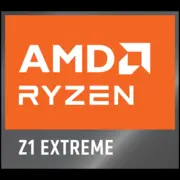AMD Ryzen Z1 Extreme

AMD Ryzen Z1 Extreme: Power and Efficiency in a Compact Form Factor
Introduction
Modern laptops require a balance between performance, battery life, and portability. The AMD Ryzen Z1 Extreme is a processor designed for devices that need to handle gaming, creative tasks, and work without compromises. Let’s take a closer look at how it achieves this and who should pay attention to the chip codenamed Phoenix.
1. Architecture and Process Technology: Zen 4, 4nm, and Hybrid Graphics
Zen 4: Evolution of Performance
The Ryzen Z1 Extreme is built on the Zen 4 architecture, which is the foundation for AMD's mobile processors for the 2023-2024 generation. The 4nm process technology from TSMC allows for the integration of 8 cores and 16 threads in a compact die while maintaining low power consumption.
- Cores and Frequencies: All 8 cores are full-fledged “big” cores (unlike Intel’s hybrid structure). The base frequency is 3.3 GHz, but in turbo mode, it reaches 5.1 GHz for a single core or 4.9 GHz under full load.
- Cache Memory: The 16 MB L3 cache accelerates data processing in games and multithreaded applications.
Integrated Graphics Radeon 780M
The iGPU Radeon 780M is one of the key advantages of the processor. It features RDNA 3 architecture with 12 compute units (CUs), and a frequency of up to 2.8 GHz. This performance is comparable to an entry-level discrete graphics card, such as the NVIDIA MX550, but with support for AMD's FSR and Ray Tracing technologies.
Example: In Cyberpunk 2077 at medium settings (1080p + FSR Quality), the chip delivers 35-40 FPS. This is impressive for integrated graphics.
2. Power Consumption and TDP: Flexibility for Ultrabooks and Compact PCs
The TDP of the processor ranges from 9W to 30W, allowing it to be used in various device categories:
- 9-15W: Ultrabooks with passive cooling (e.g., ASUS Zenbook S13).
- 25-30W: Compact gaming laptops (ROG Ally, Lenovo Legion Go).
Note: Maximum performance is achieved at a TDP of 30W. In 15W mode, Multi-Core Geekbench 6 performance drops by 25%, but battery life increases by 40-50%.
3. Performance: Gaming, Rendering, and Office Tasks
Office and Multimedia
- Microsoft Office, Browsers: The 16 threads easily handle multiple tabs and background applications.
- Adobe Photoshop/Lightroom: Exporting 100 RAW photos takes about 2.5 minutes (for comparison, Intel Core i7-1260P takes about 3 minutes).
Gaming
- Cyberpunk 2077 (1080p, medium settings): 35-40 FPS.
- Elden Ring (720p, low settings): 45-50 FPS.
- eSports (CS2, Dota 2): Over 100 FPS at Full HD.
Turbo Mode: When activated (e.g., via the AMD Ryzen Master utility), the processor briefly boosts to 5.1 GHz, but this causes temperatures to rise to 95°C. In compact devices, this can lead to throttling without an efficient cooling system.
4. Use Cases: Who is the Ryzen Z1 Extreme Suitable For?
- Gamers: Owners of portable consoles (ROG Ally) or compact laptops with eGPU support.
- Creative Professionals: Video editing on the go in Premiere Pro, rendering 3D models in Blender.
- Students and Office Users: Multitasking with moderate gaming capabilities.
Example: The ASUS ROG Flow X13 with Ryzen Z1 Extreme and an external RTX 4070 graphics card transforms into a mobile workstation.
5. Battery Life: How TDP Affects Operating Time
At 9W TDP and a 75W·h battery, runtime reaches 10-12 hours (web surfing, video). In 30W mode, it lasts no more than 3-4 hours.
Energy-Saving Technologies:
- Precision Boost 2: Dynamically adjusts frequencies based on workload.
- SmartShift: Redistributes power between CPU and GPU.
Tip: For extended use, activate the "Battery Saver" mode in Windows, limiting TDP to 15W.
6. Comparison with Competitors
AMD Ryzen 7 7840U
- Similar specs but a TDP of up to 28W. Z1 Extreme is optimized for gaming, while the 7840U is aimed at ultrabooks.
Intel Core i7-1360P
- 12 cores (4P + 8E), but in gaming, Radeon 780M is 30% faster than Iris Xe.
Apple M2
- Better power efficiency (up to 18 hours of battery life) but weaker in gaming and Windows applications.
7. Pros and Cons
Strengths:
- High CPU/GPU performance in its class.
- Support for DDR5-5600 and PCIe 4.0.
- Flexible TDP for various devices.
Weaknesses:
- Heating under maximum load.
- Dependence on cooling systems: may throttle in thin laptops.
8. Recommendations for Laptop Selection
- Ultrabooks: Look for models with TDP of 15-20W and passive cooling (e.g., Acer Swift X).
- Portable Consoles: Consider the ASUS ROG Ally for optimized gaming performance.
- Workstations: Devices with eGPU support and a 120Hz display (e.g., ASUS Flow X13).
What to Check Before Buying:
- Real performance in stress tests (Cinebench R23, 3DMark).
- Fan noise levels.
- The possibility of manual TDP adjustment.
9. Final Conclusion
The AMD Ryzen Z1 Extreme is an ideal choice for those who need a versatile processor in a compact package. It is suitable for:
- Gamers who want to play without a bulky laptop.
- Designers and videographers working on the go.
- Users who appreciate the balance between battery life and power.
Key Advantages: Strong integrated graphics, support for modern standards, and adaptability for various scenarios. If you're willing to deal with heat under peak loads, the Z1 Extreme will be an excellent companion in mobile life.
Basic
CPU Specifications
Memory Specifications
GPU Specifications
Benchmarks
Compared to Other CPU
Share in social media
Or Link To Us
<a href="https://cputronic.com/cpu/amd-ryzen-z1-extreme" target="_blank">AMD Ryzen Z1 Extreme</a>